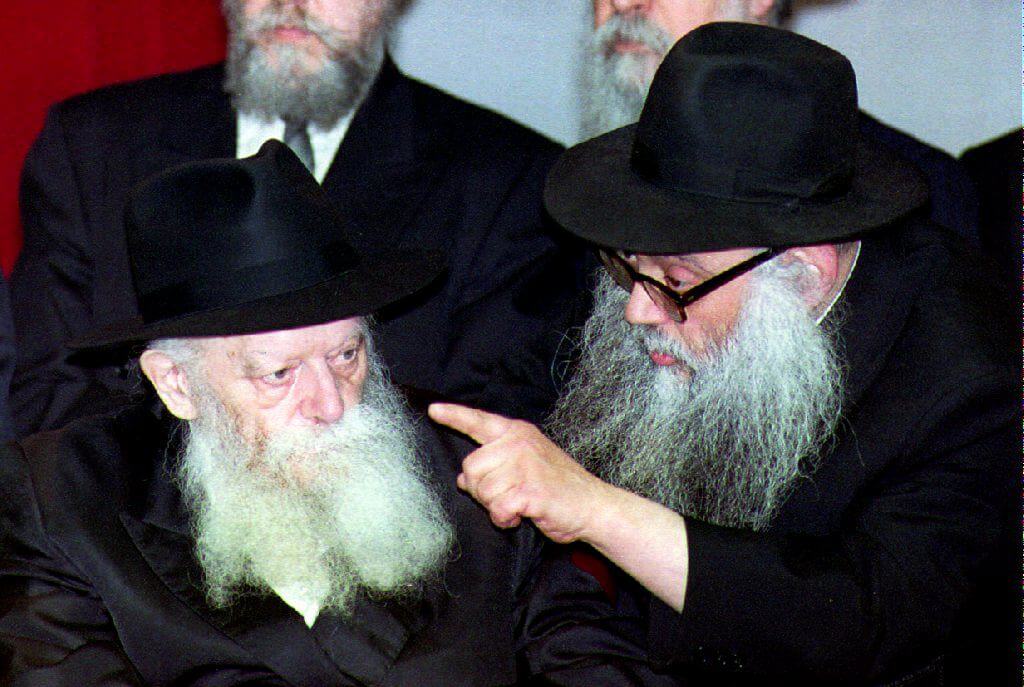How do you solve a conundrum like Menachem Mendel Schneerson?
The charismatic Rebbe, who died in 1994, is the subject of Ezra Glinter’s ‘Jewish Lives’ biography

Menachem Mendel Schneerson listening to one of his advisors in 1993. Photo by Getty Images
Menachem Mendel Schneerson: Becoming the Messiah
By Ezra Glinter
Yale Univesity Press, 320 pages, $28
Jewish Lives, the laudable series of short, reflective biographies published by Yale University Press, includes volumes on such canonical figures as Solomon, Elijah and Maimonides. But it has also generously counted Bugsy Siegel, Marcel Proust, and Ayn Rand as “Jewish.” Most of the series’ subjects, like Peggy Guggenheim, Stanley Kubrick and Mark Rothko, led entirely secular lives; some, like Karl Marx, were even downright hostile to Judaism, and others, including Benjamin Disraeli and Heinrich Heine, converted to Christianity. Baruch Spinoza was expelled from the Jewish community of Amsterdam. So the latest addition to Jewish Lives, the most recent Rebbe of the Lubavitch Hasidic dynasty, joins strange company.
Menachem Mendel Schneerson, who died in 1994 at the age of 92, was the charismatic leader of a worldwide cult of personality that he expanded into a global phenomenon. One of the challenges that Ezra Glinter, a senior staff writer at the Yiddish Book Center and a former editor at the Forward, faced in writing about Schneerson was finding any space between public and private selves. After his installation as leader of the Chabad in 1951, the Rebbe lived entirely in his work. He ate and slept a bare minimum, took no vacations, rarely ventured out of Brooklyn, and spent most of his time in a small, dingy office at 770 Eastern Parkway, headquarters of the movement. Glinter was able to draw upon extensive writings and talks by Schneerson, but official pronouncements on matters of doctrine leave one wondering about the man beneath the shtreimel and kapote.
The question of who the Rebbe was is all the more tantalizing given his history before his escape to America in 1941. Born in Nikolaeva in what is now Ukraine in 1902, he studied engineering at secular universities in Berlin and Paris and showed little inclination toward a career in religious leadership. “How did this private scholar become one of the most charismatic holy men of the century?” asks Glinter.
Part of the answer is in Schneerson’s marriage to Chaya Mushka, a daughter of Yosef Yitshak Schneerson (they were distantly related), the sixth Lubavitcher Rebbe. After the death of his father-in-law, who had no sons, Schneerson outmaneuvered his brother-in-law for command of Chabad. He transformed himself utterly into the movement’s sage, sympathetic Rebbe, and, in the 30 years since his death, no one has taken his place.
As a self-described nonbeliever, Glinter concedes the difficulty of understanding someone whose tens of thousands of fervent followers often hailed him as the Messiah. Intent on presenting Schneerson in his own terms, he conveys the atmosphere of one of the Rebbe’s farbrengens — in which as many as a thousand Hasidim would crowd into a room at 770 Eastern Parkway to hear a Talmudic disquisition of “breathtaking virtuosity.”
Glinter also reports that some were put to sleep. He notes the Rebbe’s organizational genius in extending the Lubavitcher outreach to unlikely places throughout the world. And he marks his political influence ‚ even, and especially, in Israel, a country he never visited. The eleventh of Nissan is Schneerson’s birthday, and in 1978 the United States Congress proclaimed the annual observance of Education and Sharing Day in his honor. On July 9, 2024, Ukraine issued a postage stamp to commemorate the Rebbe.
While Schneerson was an advocate for prison reform, gun control, and solar energy, he opposed birth control, gay rights, and the separation of church and state.
“Everything lay within the scope of Jewish teaching,” Glinter writes, “but that meant everything had to be understood only insofar as Judaism — and Schneerson’s interpretation of Judaism — permitted.” His fundamentalist positions hardened into rigid dogmas.
It is impertinent and impossible to ask a deceased prophet who left no children or close friends about the mundane matters that constitute most lives. What, beyond Torah and Chabad, were Schneerson’s passions and preferences? Glinter fills the void with context — the history of Hasidism, the institutional network of Chabad, the changing demographics of Crown Heights, where the Lubavitchers are headquartered and where Jews have come to feel besieged. He is forced to concentrate on the outer life of a messianic figure — saint or charlatan? — whose entire focus was inward.
A message from our CEO & publisher Rachel Fishman Feddersen
I hope you appreciated this article. Before you go, I’d like to ask you to please support the Forward’s award-winning, nonprofit journalism during this critical time.
We’ve set a goal to raise $260,000 by December 31. That’s an ambitious goal, but one that will give us the resources we need to invest in the high quality news, opinion, analysis and cultural coverage that isn’t available anywhere else.
If you feel inspired to make an impact, now is the time to give something back. Join us as a member at your most generous level.
— Rachel Fishman Feddersen, Publisher and CEO